Friday, December 30, 2005
MY LAST POST THIS YEAR...
Wednesday night was the busiest night at the izakaya. I must have been really exhausted when I got home around midnight… Next morning I woke up feeling awfully heavy. When I was getting dressed around noon to go to work, I found my jacket hanging in the closet instead of the place where I always hang it, and I had absolutely no memory of hanging it in the closet after coming back from work that night.
I’m leaving for my parents’ house early Saturday morning. They are calling for rain on the New Year’s Day. Gee, when was the last time we had a rainy New Year’s Day ...?
-----
My next entry will be posted in 2006, the year of the dog ;)
I truly want to thank you all for supporting my humble blogs this year.
I wish you all a Happy New Year.
May your new year be better than ever.
I’m leaving for my parents’ house early Saturday morning. They are calling for rain on the New Year’s Day. Gee, when was the last time we had a rainy New Year’s Day ...?
-----
My next entry will be posted in 2006, the year of the dog ;)
I truly want to thank you all for supporting my humble blogs this year.
I wish you all a Happy New Year.
May your new year be better than ever.
Sunday, December 25, 2005
Merry Christmas
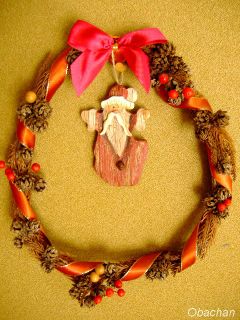
I wish you all a wonderful holiday season.
*** Merry Christmas ***
Thursday, December 22, 2005
IT SNOWED LAST NIGHT
When I wake up in the morning, the first thing I do is to grab a remote and turn on the TV. I watch TV morning show for about 30 minutes in bed, asking myself a permission to stay in bed for“5 more minutes”again and again. This morning, the first news I saw was about the snowfall in this area (again!), so I got out of bed right away and opened the curtain.
 Yes, it snowed! I was thinking about getting some straw from somewhere to keep my blueberry plant warm, but I guess I waited too long (as usual…).
Yes, it snowed! I was thinking about getting some straw from somewhere to keep my blueberry plant warm, but I guess I waited too long (as usual…).
I need to work in the afternoon today and hope the snow on the street would completely melt by then. Otherwise my bicycle might slip on the melting snow… :( Good thing is that I don’t have to work tonight. I can do a major shopping on my way back from work this afternoon, and work on cleaning my room for the rest of the day. I’ve decided to “have a Christmas dinner in a tidy room” this year, so cleaning would keep me quite busy tonight.
 Yes, it snowed! I was thinking about getting some straw from somewhere to keep my blueberry plant warm, but I guess I waited too long (as usual…).
Yes, it snowed! I was thinking about getting some straw from somewhere to keep my blueberry plant warm, but I guess I waited too long (as usual…).I need to work in the afternoon today and hope the snow on the street would completely melt by then. Otherwise my bicycle might slip on the melting snow… :( Good thing is that I don’t have to work tonight. I can do a major shopping on my way back from work this afternoon, and work on cleaning my room for the rest of the day. I’ve decided to “have a Christmas dinner in a tidy room” this year, so cleaning would keep me quite busy tonight.
Wednesday, December 21, 2005
WEEKEND AT MY PARENTS' HOUSE
Last weekend I visited my parents’ house and picked oranges in my dad’s orchard with my parents.
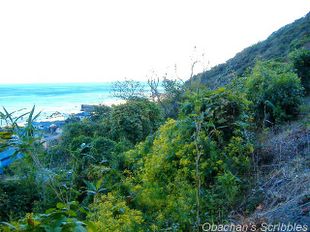
In my hometown, oranges are grown on the mountain slope close to the ocean. It is our privilege to enjoy the nice view of the ocean as we pick oranges in the orchard.

Ponkan (Citrus reticulata blanco) orange trees.
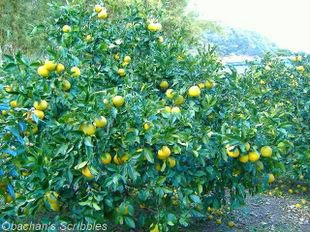
Buntan (Citrus grandis) orange trees. We are not picking buntan until January or later.
We picked ponkan oranges all afternoon and dad brought them down to the storage house.

 These are young konatsu orange trees covered with straw (to prevent them from freezing?)
These are young konatsu orange trees covered with straw (to prevent them from freezing?)
 On Sunday morning, we sorted the ponkan oranges according to size. To sort them into S, M, L, 2L and 3L size groups, we used the wood plate with different-sized holes, which has been handed down from my grandpa's generation.
On Sunday morning, we sorted the ponkan oranges according to size. To sort them into S, M, L, 2L and 3L size groups, we used the wood plate with different-sized holes, which has been handed down from my grandpa's generation.
I heard that it snowed a lot in Kochi city that weekend, but this is how the ocean and the sky looked on Sunday in Muroto.

Aloe flowers

The big rocks near the mountain are called myoto-iwa (wedded rocks).

In my hometown, oranges are grown on the mountain slope close to the ocean. It is our privilege to enjoy the nice view of the ocean as we pick oranges in the orchard.

Ponkan (Citrus reticulata blanco) orange trees.

Buntan (Citrus grandis) orange trees. We are not picking buntan until January or later.
We picked ponkan oranges all afternoon and dad brought them down to the storage house.

 These are young konatsu orange trees covered with straw (to prevent them from freezing?)
These are young konatsu orange trees covered with straw (to prevent them from freezing?) On Sunday morning, we sorted the ponkan oranges according to size. To sort them into S, M, L, 2L and 3L size groups, we used the wood plate with different-sized holes, which has been handed down from my grandpa's generation.
On Sunday morning, we sorted the ponkan oranges according to size. To sort them into S, M, L, 2L and 3L size groups, we used the wood plate with different-sized holes, which has been handed down from my grandpa's generation.I heard that it snowed a lot in Kochi city that weekend, but this is how the ocean and the sky looked on Sunday in Muroto.

Aloe flowers

The big rocks near the mountain are called myoto-iwa (wedded rocks).
Tuesday, December 13, 2005
WHAT I WAS DOING IN DECEMBER 1995
Tonight I was going through my old stuff I brought back from Osaka when I moved to Kochi in 2000. I couldn’t find what I was looking for, but instead, I found this photo.
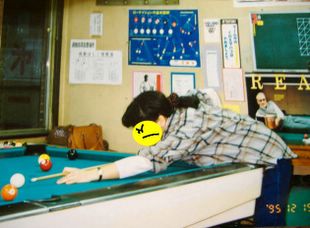
This is me ten years ago, shooting pool. Yeah, my hair was longer then.
I really loved the Paul Newman poster on the wall, but this pool hall closed after I came back to Kochi, and I don’t know what happened to the poster.
Maybe it was thrown away...

This is me ten years ago, shooting pool. Yeah, my hair was longer then.
I really loved the Paul Newman poster on the wall, but this pool hall closed after I came back to Kochi, and I don’t know what happened to the poster.
Maybe it was thrown away...
Sunday, December 11, 2005
NEW TEMPLATE
It’s already December, so I felt like a winter scenery instead of maple leaves. For the 24th and 25th this month, I’ll look for a special Christmas version, and hopefully I can change it to a New Year’s Day version before I leave for my parents’ house on Dec. 30. Fun, fun... ;)
Friday, December 09, 2005
FIRE-WALKING AT KOHOJI TEMPLE (December 4, 2005)
Ever since I started this blog more than a year ago, I have been enjoying re-discovering the value of our local customs. Attending traditional events are fun, eye-opening, enchanting, intellectually stimulating and sometimes healing… But I never knew that observing a traditional ceremony can be that physically challenging. :D Last Sunday, I went to a temple to see a big bonfire ceremony, and it was a real unforgettable experience.
I had read about this festival in a community newsletter, got interested, and checked the location of the temple on the map beforehand. It was not too far from where I live, so I decided to go by bicycle. As I went closer to the destination, I hated myself for not having paid more attention to the contours on the map. The temple was in a mountainous area, and the slope got steeper and steeper. Finally I realized that walking was much easier, so I pushed my bicycle and walked. The newsletter said “Take the steps from the main road to the temple.” I expected to go up from there, but actually the steps were ...


Yeah, right… there are steps indeed… The newsletter didn't lie. But...
What did I climb up the hill that much for ???
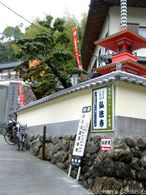 Anyway, at the temple, the ceremony was about to start.
Anyway, at the temple, the ceremony was about to start.
According to the newsletter article, this event was a sort of collaboration of Shinto and Buddhism rituals aiming at getting rid of troubles/ worries, and welcoming good luck, health and family safety. Many of you might find this strange, but the fact is that in Japan, the two religions -- Shinto and Buddhism -- uniquely co-exist.
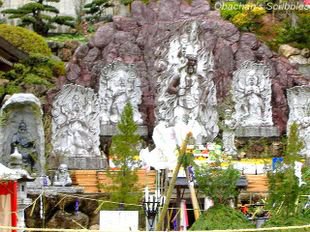 Ancient rulers of Japan imported and supported Buddhism enthusias- tically not only for its religious value but also for importing advanced culture and technology from abroad with the religion. They taught Japanese people that both Japanese gods and Buddha would cooperatively help and make them happy. So still today, most of regular Japanese households celebrate both Shinto and Buddhist ceremonies. (That’s what I think I understood from our history class in jr. high. I was not a good student, so corrections, please.)
Ancient rulers of Japan imported and supported Buddhism enthusias- tically not only for its religious value but also for importing advanced culture and technology from abroad with the religion. They taught Japanese people that both Japanese gods and Buddha would cooperatively help and make them happy. So still today, most of regular Japanese households celebrate both Shinto and Buddhist ceremonies. (That’s what I think I understood from our history class in jr. high. I was not a good student, so corrections, please.)


At the temple, branches of Japanese cypress were piled up in the center of a square, roped-off area near many Buddhist statues. After a while, Buddhist monks in colorful costumes, yamabushi (mountain priests?) with conch-shell horns and Shinto priests came into the square. There were kid priests, too.

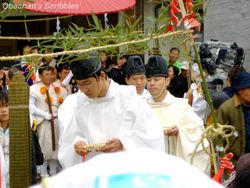

 Then a dialogue took place between the host mountain priest and mountain priests from a distant prefecture, waiting outside the square. The host asked the leader of the visitors questions to test their religious knowledge, and they were allowed into the square after the leader answered all the questions.
Then a dialogue took place between the host mountain priest and mountain priests from a distant prefecture, waiting outside the square. The host asked the leader of the visitors questions to test their religious knowledge, and they were allowed into the square after the leader answered all the questions.
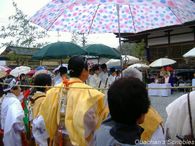 It was a chilly, cloudy day and it finally started raining in the middle of the ceremony!! Of course the ceremony went on and we had to use umbrellas or rain coats. Many of the attendants were elder people and I was worried that they might catch a cold.
It was a chilly, cloudy day and it finally started raining in the middle of the ceremony!! Of course the ceremony went on and we had to use umbrellas or rain coats. Many of the attendants were elder people and I was worried that they might catch a cold.
Some rituals were performed to chase the evils away and purify the area. After a guy showed a performance with chained sickles, four guys cut rolled rush mats facing four directions. That was supposed to slay the evils in north, south, east and west.
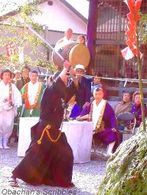
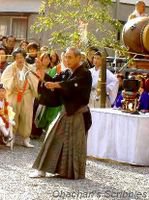
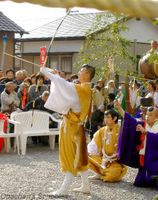
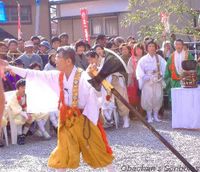
The arrow and the ax were also supposed to kill the evils and purify the area.
 Finally, they started burning the cypress branches!!
Finally, they started burning the cypress branches!!
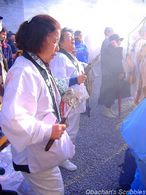 OMG, the smoke!! The audience in the front row including myself started coughing and tearing because of the thick smoke. But some enthusiastic visitors kept chanting in the front row. This smoke was supposed to purify us (and I was positive that any germs on/inside of me were smoldered to death.) ;P
OMG, the smoke!! The audience in the front row including myself started coughing and tearing because of the thick smoke. But some enthusiastic visitors kept chanting in the front row. This smoke was supposed to purify us (and I was positive that any germs on/inside of me were smoldered to death.) ;P
Then the cypress branches started burning with a big flame! Now we got so hot, even with the mountain priests standing in front of us throwing flat, long wood pieces into the fire. I assume those wood pieces had the visitors’ wishes written on, and they were burned so that the wishes would go up in the air with the smoke to reach someone above in heaven. This fire is also supposed to burn our worries and negative feelings such as jealous, greed and hatred.
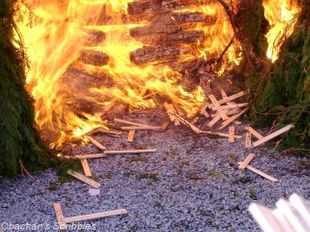 This reminded me of the "sweat lodge ceremony" that I attended when I was in Arizona more than 10 years ago. IIRC, they encouraged participants to take out the negative feelings onto the fire (or was it heated rocks or something?) burning in the shallow pit in the ground inside the sweat lodge. They said that the ancestors would come to the fire and take care of the negative feelings.
This reminded me of the "sweat lodge ceremony" that I attended when I was in Arizona more than 10 years ago. IIRC, they encouraged participants to take out the negative feelings onto the fire (or was it heated rocks or something?) burning in the shallow pit in the ground inside the sweat lodge. They said that the ancestors would come to the fire and take care of the negative feelings.
Western Psychology I studied in the States taught me the importance and technique of taking negative, “circular thinking” out of our system to be freed from it and be able to deal with it so that we can move forward. And now back in Japan, I see these people dealing with the negative side of human nature in this way, and the tradition has been handed down for hundreds of years…
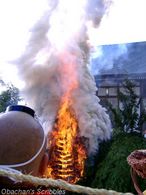 To me all these things seem to share the same, very basic and universal wisdom at their basis. Perhaps, we all shared the same wisdom from ancient times, and each culture has developed its own unique way of embodying and handing down the wisdom. Of course, this is an overly simplified view. I don’t mean to disrespect the differences. Yet I prefer seeing people in the world as “the same AND different,”and when I think about it, I feel much closer to all the people in the world, though I’m aware how naive this may sound...
To me all these things seem to share the same, very basic and universal wisdom at their basis. Perhaps, we all shared the same wisdom from ancient times, and each culture has developed its own unique way of embodying and handing down the wisdom. Of course, this is an overly simplified view. I don’t mean to disrespect the differences. Yet I prefer seeing people in the world as “the same AND different,”and when I think about it, I feel much closer to all the people in the world, though I’m aware how naive this may sound...
As the fire got smaller, the priests flattened the charcoals and ashes which were still hot. Now it was time for the “fire walking ritual.” I’ve seen mountain priests walking on fire like this on TV before, so I knew it was part of their training. Then to my surprise, I heard an announcement, “Those who want to participate in the fire-walking, please buy a gohei (paper ornament for Shinto ritual) and hold it in your hands.” What?! Do the visitors also walk on the hot charcoals in bear feet? You mean these grandmas and grandpas? I thought they would place something over the hot ashes for the regular people to walk on.


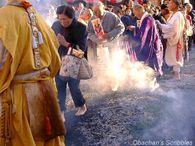 To my surprise, nothing was placed on the hot charcoals/ashes. First the priests, then the visitors --- grandmas, grandpas, younger people and even kids --- walked barefoot over still smoldering charcoals. I was really curious what it would feel like. No one seemed to have been injured, even elder people who could walk only slowly, so obviously it was safe. Then why not me?! But unfortunately I forgot to bring my wallet and couldn’t buy the gohei paper…
To my surprise, nothing was placed on the hot charcoals/ashes. First the priests, then the visitors --- grandmas, grandpas, younger people and even kids --- walked barefoot over still smoldering charcoals. I was really curious what it would feel like. No one seemed to have been injured, even elder people who could walk only slowly, so obviously it was safe. Then why not me?! But unfortunately I forgot to bring my wallet and couldn’t buy the gohei paper…
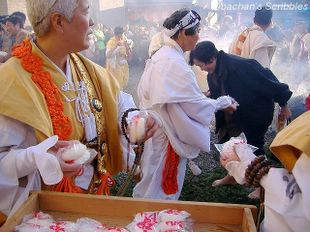
Rice cakes were given to those who finished fire-walking
So that day, everyone there including myself went through quite a bit of challenges. It was freezing cold to start with, and we got wet in the rain, then smoked, nearly roasted and finally frozen again by the cold wind. I was just happy that I didn’t get sick after coming home that day. I hope this fire-walking saved those grandpas and grandmas from getting sick after that challenging day. :)
I had read about this festival in a community newsletter, got interested, and checked the location of the temple on the map beforehand. It was not too far from where I live, so I decided to go by bicycle. As I went closer to the destination, I hated myself for not having paid more attention to the contours on the map. The temple was in a mountainous area, and the slope got steeper and steeper. Finally I realized that walking was much easier, so I pushed my bicycle and walked. The newsletter said “Take the steps from the main road to the temple.” I expected to go up from there, but actually the steps were ...


Yeah, right… there are steps indeed… The newsletter didn't lie. But...
What did I climb up the hill that much for ???
 Anyway, at the temple, the ceremony was about to start.
Anyway, at the temple, the ceremony was about to start.According to the newsletter article, this event was a sort of collaboration of Shinto and Buddhism rituals aiming at getting rid of troubles/ worries, and welcoming good luck, health and family safety. Many of you might find this strange, but the fact is that in Japan, the two religions -- Shinto and Buddhism -- uniquely co-exist.
 Ancient rulers of Japan imported and supported Buddhism enthusias- tically not only for its religious value but also for importing advanced culture and technology from abroad with the religion. They taught Japanese people that both Japanese gods and Buddha would cooperatively help and make them happy. So still today, most of regular Japanese households celebrate both Shinto and Buddhist ceremonies. (That’s what I think I understood from our history class in jr. high. I was not a good student, so corrections, please.)
Ancient rulers of Japan imported and supported Buddhism enthusias- tically not only for its religious value but also for importing advanced culture and technology from abroad with the religion. They taught Japanese people that both Japanese gods and Buddha would cooperatively help and make them happy. So still today, most of regular Japanese households celebrate both Shinto and Buddhist ceremonies. (That’s what I think I understood from our history class in jr. high. I was not a good student, so corrections, please.)

At the temple, branches of Japanese cypress were piled up in the center of a square, roped-off area near many Buddhist statues. After a while, Buddhist monks in colorful costumes, yamabushi (mountain priests?) with conch-shell horns and Shinto priests came into the square. There were kid priests, too.



 Then a dialogue took place between the host mountain priest and mountain priests from a distant prefecture, waiting outside the square. The host asked the leader of the visitors questions to test their religious knowledge, and they were allowed into the square after the leader answered all the questions.
Then a dialogue took place between the host mountain priest and mountain priests from a distant prefecture, waiting outside the square. The host asked the leader of the visitors questions to test their religious knowledge, and they were allowed into the square after the leader answered all the questions. It was a chilly, cloudy day and it finally started raining in the middle of the ceremony!! Of course the ceremony went on and we had to use umbrellas or rain coats. Many of the attendants were elder people and I was worried that they might catch a cold.
It was a chilly, cloudy day and it finally started raining in the middle of the ceremony!! Of course the ceremony went on and we had to use umbrellas or rain coats. Many of the attendants were elder people and I was worried that they might catch a cold.Some rituals were performed to chase the evils away and purify the area. After a guy showed a performance with chained sickles, four guys cut rolled rush mats facing four directions. That was supposed to slay the evils in north, south, east and west.




The arrow and the ax were also supposed to kill the evils and purify the area.
 Finally, they started burning the cypress branches!!
Finally, they started burning the cypress branches!! OMG, the smoke!! The audience in the front row including myself started coughing and tearing because of the thick smoke. But some enthusiastic visitors kept chanting in the front row. This smoke was supposed to purify us (and I was positive that any germs on/inside of me were smoldered to death.) ;P
OMG, the smoke!! The audience in the front row including myself started coughing and tearing because of the thick smoke. But some enthusiastic visitors kept chanting in the front row. This smoke was supposed to purify us (and I was positive that any germs on/inside of me were smoldered to death.) ;PThen the cypress branches started burning with a big flame! Now we got so hot, even with the mountain priests standing in front of us throwing flat, long wood pieces into the fire. I assume those wood pieces had the visitors’ wishes written on, and they were burned so that the wishes would go up in the air with the smoke to reach someone above in heaven. This fire is also supposed to burn our worries and negative feelings such as jealous, greed and hatred.
 This reminded me of the "sweat lodge ceremony" that I attended when I was in Arizona more than 10 years ago. IIRC, they encouraged participants to take out the negative feelings onto the fire (or was it heated rocks or something?) burning in the shallow pit in the ground inside the sweat lodge. They said that the ancestors would come to the fire and take care of the negative feelings.
This reminded me of the "sweat lodge ceremony" that I attended when I was in Arizona more than 10 years ago. IIRC, they encouraged participants to take out the negative feelings onto the fire (or was it heated rocks or something?) burning in the shallow pit in the ground inside the sweat lodge. They said that the ancestors would come to the fire and take care of the negative feelings.Western Psychology I studied in the States taught me the importance and technique of taking negative, “circular thinking” out of our system to be freed from it and be able to deal with it so that we can move forward. And now back in Japan, I see these people dealing with the negative side of human nature in this way, and the tradition has been handed down for hundreds of years…
 To me all these things seem to share the same, very basic and universal wisdom at their basis. Perhaps, we all shared the same wisdom from ancient times, and each culture has developed its own unique way of embodying and handing down the wisdom. Of course, this is an overly simplified view. I don’t mean to disrespect the differences. Yet I prefer seeing people in the world as “the same AND different,”and when I think about it, I feel much closer to all the people in the world, though I’m aware how naive this may sound...
To me all these things seem to share the same, very basic and universal wisdom at their basis. Perhaps, we all shared the same wisdom from ancient times, and each culture has developed its own unique way of embodying and handing down the wisdom. Of course, this is an overly simplified view. I don’t mean to disrespect the differences. Yet I prefer seeing people in the world as “the same AND different,”and when I think about it, I feel much closer to all the people in the world, though I’m aware how naive this may sound...As the fire got smaller, the priests flattened the charcoals and ashes which were still hot. Now it was time for the “fire walking ritual.” I’ve seen mountain priests walking on fire like this on TV before, so I knew it was part of their training. Then to my surprise, I heard an announcement, “Those who want to participate in the fire-walking, please buy a gohei (paper ornament for Shinto ritual) and hold it in your hands.” What?! Do the visitors also walk on the hot charcoals in bear feet? You mean these grandmas and grandpas? I thought they would place something over the hot ashes for the regular people to walk on.


 To my surprise, nothing was placed on the hot charcoals/ashes. First the priests, then the visitors --- grandmas, grandpas, younger people and even kids --- walked barefoot over still smoldering charcoals. I was really curious what it would feel like. No one seemed to have been injured, even elder people who could walk only slowly, so obviously it was safe. Then why not me?! But unfortunately I forgot to bring my wallet and couldn’t buy the gohei paper…
To my surprise, nothing was placed on the hot charcoals/ashes. First the priests, then the visitors --- grandmas, grandpas, younger people and even kids --- walked barefoot over still smoldering charcoals. I was really curious what it would feel like. No one seemed to have been injured, even elder people who could walk only slowly, so obviously it was safe. Then why not me?! But unfortunately I forgot to bring my wallet and couldn’t buy the gohei paper…
Rice cakes were given to those who finished fire-walking
So that day, everyone there including myself went through quite a bit of challenges. It was freezing cold to start with, and we got wet in the rain, then smoked, nearly roasted and finally frozen again by the cold wind. I was just happy that I didn’t get sick after coming home that day. I hope this fire-walking saved those grandpas and grandmas from getting sick after that challenging day. :)


